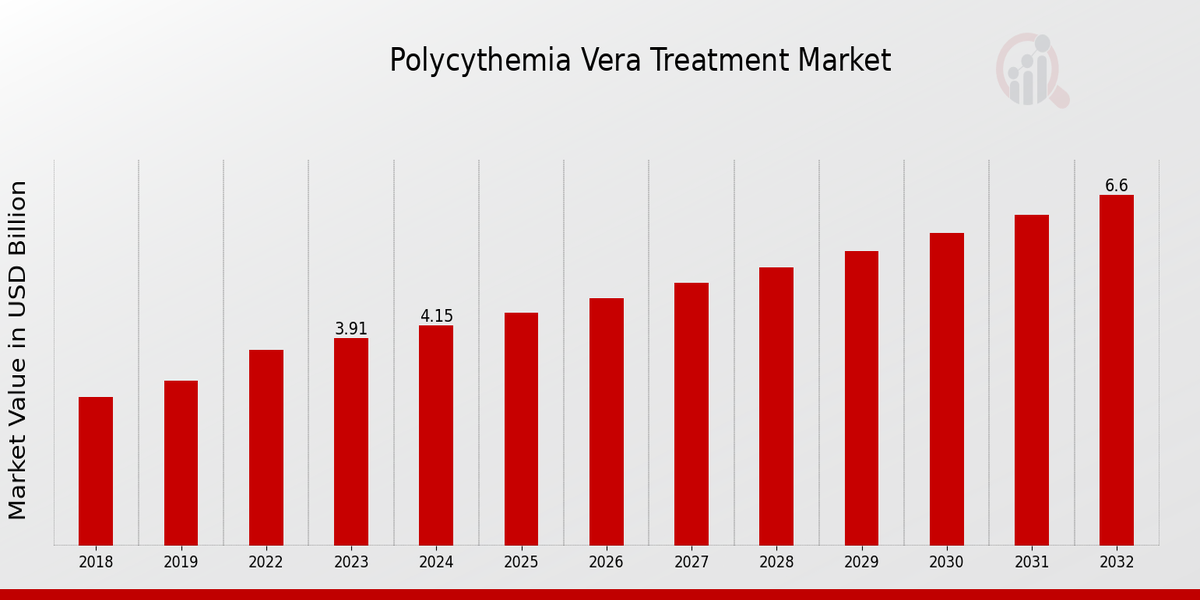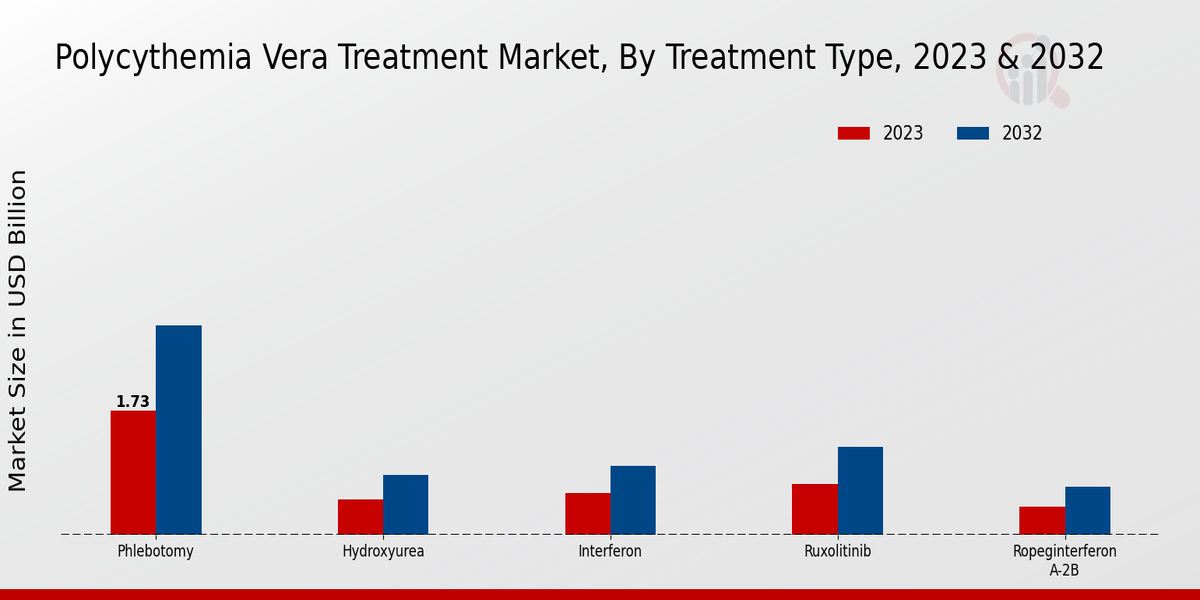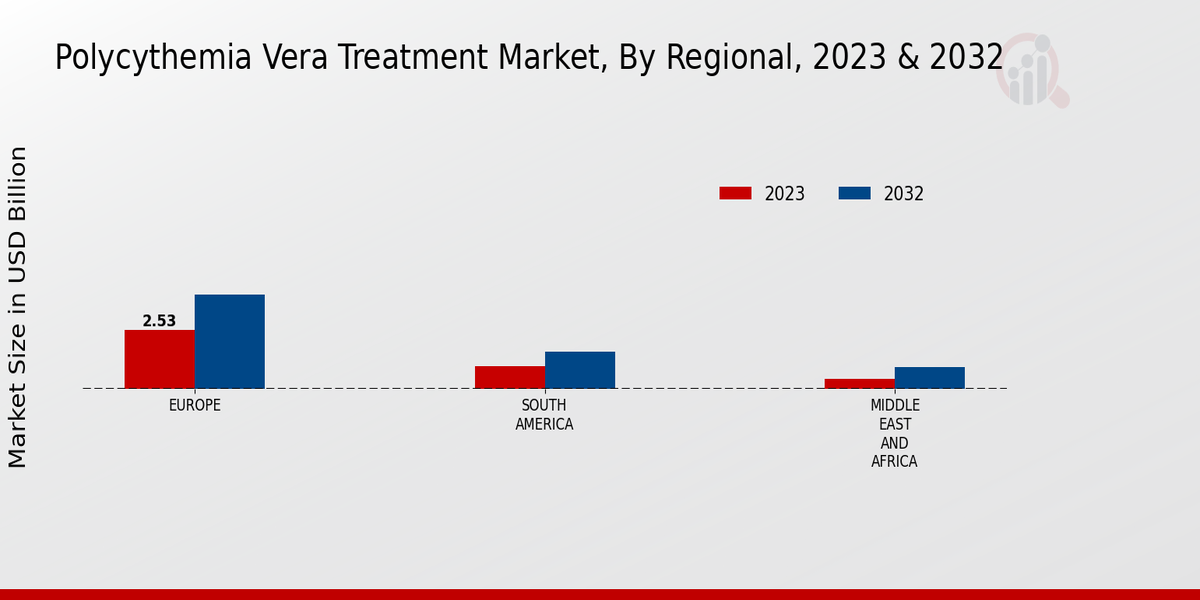Polycythemia Vera Treatment Market Overview
As per MRFR analysis, the Polycythemia Vera Treatment Market Size was estimated at 6.52 (USD Billion) in 2023. The Polycythemia Vera Treatment Market Industry is expected to grow from 7.09(USD Billion) in 2024 to 12.87 (USD Billion) by 2032. The Polycythemia Vera Treatment Market CAGR (growth rate) is expected to be around 6.85% during the forecast period (2024 - 2032).
Key Polycythemia Vera Treatment Market Trends Highlighted
The Global Polycythemia Vera Treatment Market is driven by the rising prevalence of polycythemia vera, increasing awareness, and the availability of novel therapies. The introduction of JAK2 inhibitors has revolutionized the treatment landscape, providing patients with significant benefits in symptom control and disease management. Furthermore, supportive treatments, such as phlebotomy and hydroxyurea, continue to play a crucial role in reducing disease complications. Opportunities exist for the development of targeted therapies that address specific molecular pathways and biomarkers to improve patient outcomes. Recent trends include the emergence of gene therapies and the exploration of immune-based approaches, offering the potential for long-term disease control and even a cure.

Source: Primary Research, Secondary Research, MRFR Database and Analyst Review
Polycythemia Vera Treatment Market Drivers
Rising Prevalence of Polycythemia Vera (PV)
PV (Polycythemia Vera) Polycythemia vera is a rare type of blood cancer, which is identified by the excessive production of red blood cells within the body. Among the key drivers that promote polycythemia vera’s treatments market growth is the growing pervasiveness of the disease. To illustrate, as the American Society of Hematology states, the incidence of polycythemia vera reaches approximately 2 per 100,000 persons per year. Some of the causes that may contribute to the rise of the disease’s prevalence include the increasing aging population, enhanced detection capabilities and the level of awareness regarding the disease. Additionally, as there are more PV patients, the demand and necessity for relevant treatment would increase as well.
Technological Advancements in PV Treatment
Advancements in medical technology have led to the development of more effective and targeted treatments for PV. These advancements include the development of new drugs, such as JAK inhibitors, which have shown promising results in reducing PV symptoms and improving patient outcomes. The availability of these new treatment options has increased the demand for polycythemia vera treatments as patients seek more effective and less invasive therapies. The Global Polycythemia Vera Treatment Market Industry is expected to benefit from the continued development and adoption of new technologies in PV treatment.
Growing Emphasis on Personalized Medicine
Personalized medicine approaches tailored to individual patient needs are becoming increasingly important in the treatment of PV. This involves using genetic testing and other diagnostic tools to identify the specific genetic mutations or molecular characteristics that are driving the disease in each patient. Personalized treatment plans can then be developed to target these specific abnormalities, leading to more effective and individualized care. The growing emphasis on personalized medicine in PV treatment is expected to drive market growth for polycythemia vera treatments, as it allows for more precise and effective treatment strategies for each patient.
Polycythemia Vera Treatment Market Segment Insights
Polycythemia Vera Treatment Market Treatment Type Insights
The Global Polycythemia Vera Treatment Market is segmented by Treatment Type into Phlebotomy, Hydroxyurea, Interferon, Ruxolitinib, Ropeginterferon a-2b, and Other Targeted Therapies. Phlebotomy, a procedure to remove excess red blood cells from the body, is the most common treatment for polycythemia vera. Hydroxyurea, an oral medication, is another common treatment option. Interferon, a type of protein produced by the body's immune system, can also be used to treat polycythemia vera. Ruxolitinib, a newer medication, is used to treat patients who are resistant to other treatments.Ropeginterferon a-2b is a long-acting form of interferon that is administered once every two weeks. The growth of the market is attributed to the increasing prevalence of polycythemia vera and the development of new and more effective treatments. The rising demand for minimally invasive and targeted therapies is also driving the growth of the market. The market for polycythemia vera treatment is highly competitive, with a number of major players. The key players in the market include Novartis, Bristol-Myers Squibb, Incyte, and Roche. These companies are investing heavily in research and development to develop new and more effective treatments for polycythemia vera.

Source: Primary Research, Secondary Research, MRFR Database and Analyst Review
Polycythemia Vera Treatment Market Disease Severity Insights
Market Research on Polycythemia Vera Treatment also segmented the Global Polycythemia Vera Treatment Market by Disease Severity into Low-Risk, Intermediate-Risk, and High-Risk. The Intermediate-Risk segment held the largest share of the market revenue, approximately 45%, in 2023 and is expected to grow at the highest CAGR of 6.5%. The High-Risk segment is estimated to grow more owing to the increasing number of high-risk polycythemia vera patients, rising awareness of the disease, and the introduction of new potent drugs.
Polycythemia Vera Treatment Market Line of Therapy Insights
The Global Polycythemia Vera Treatment Market is segmented into different therapy lines, including First-Line, Second-Line, Third-Line and Beyond.
The First-Line treatment segment held the largest market share in 2023, and it is expected to maintain its dominance throughout the forecast period. This is primarily due to the increasing adoption of JAK inhibitors, such as ruxolitinib, as the preferred first-line therapy for Polycythemia Vera patients.
The Second-Line treatment segment is expected to witness significant growth over the forecast period, owing to the growing number of patients becoming resistant to first-line therapies and the introduction of novel agents. The Third-Line and Beyond treatment segment is expected to grow at a slower pace compared to the other segments due to the limited number of treatment options available for patients who have failed multiple lines of therapy.
Polycythemia Vera Treatment Market Patient Population Insights
The Global Polycythemia Vera Treatment Market segmentation by Patient Population offers valuable insights into the specific requirements and characteristics of different patient groups. The market is primarily divided into three key segments: Newly Diagnosed, Relapsed/Refractory, and Elderly. Newly Diagnosed patients with Polycythemia Vera account for a significant proportion of the market. These patients require comprehensive treatment plans that address their immediate symptoms and prevent long-term complications. The market revenue for this segment is projected to reach $1.2 billion by 2024, driven by increasing awareness and early diagnosis rates.Relapsed/Refractory patients represent another critical segment, accounting for approximately 20% of the global Polycythemia Vera Treatment Market. These patients have failed or shown resistance to initial treatments, necessitating aggressive therapeutic approaches. The market revenue for this segment is estimated to grow at a CAGR of 6.5% over the forecast period, reflecting the need for innovative and personalized treatment strategies. Elderly patients with Polycythemia Vera pose unique challenges due to age-related comorbidities and reduced tolerance to certain treatments.This segment is expected to experience steady growth in the coming years, driven by the increasing prevalence of Polycythemia Vera in older populations. The market revenue for this segment is projected to reach $0.8 billion by 2024, underscoring the importance of age-specific treatment considerations.
Polycythemia Vera Treatment Market Regional Insights
The Global Polycythemia Vera Treatment Market is segmented into North America, Europe, APAC, South America and MEA. North America and Europe collectively held a market share of over 75% in 2023 and are expected to maintain their dominance throughout the forecast period. The large patient population, well-established healthcare infrastructure, and high adoption of advanced treatment modalities contribute to the growth of these regions. APAC is anticipated to witness the fastest growth during the forecast period, owing to increasing awareness about the disease, growing prevalence, and expanding access to healthcare services.South America and MEA also represent significant markets for Polycythemia Vera treatment, with growth driven by improving healthcare systems and increasing investment in healthcare infrastructure.

Source: Primary Research, Secondary Research, MRFR Database and Analyst Review
Polycythemia Vera Treatment Market Key Players And Competitive Insights
Major players in Polycythemia Vera Treatment Market are continuously striving to develop more effective and tolerable therapies for patients with polycythemia vera. Collaborative research and development efforts between pharmaceutical companies and academic institutions are contributing to the advancement of the treatment landscape. Key players include Incyte, Bristol-Myers Squibb, Novartis, and Pfizer.Among the leading Polycythemia Vera Treatment Market players, Incyte stands out with its JAK1/2 inhibitor, ruxolitinib, which has demonstrated significant efficacy and safety in the treatment of polycythemia vera. Ruxolitinib has received approval from regulatory authorities in various countries and has become a widely used therapy for patients with this condition. Other notable players include Bristol-Myers Squibb with its second-generation JAK1/2 inhibitor, fedratinib, and Novartis with its PI3K inhibitor, alpelisib. The competitive landscape of the Polycythemia Vera Treatment Market is expected to remain dynamic, with ongoing research and development efforts aiming to improve treatment outcomes for patients.A prominent competitor in the Polycythemia Vera Treatment Market is Bristol-Myers Squibb. The company has a strong presence in the hematology space and is committed to developing innovative therapies for patients with blood cancers. Bristol-Myers Squibb's fedratinib is a selective JAK2 inhibitor that has shown promising results in clinical trials. The company is actively pursuing regulatory approvals for fedratinib and is expected to play a significant role in shaping the future of polycythemia vera treatment.
Key Companies in the Polycythemia Vera Treatment Market Include
Polycythemia Vera Treatment Market Industry Developments
The global Polycythemia Vera Treatment Market is projected to reach USD 12.87 billion by 2032, growing at a CAGR of 6.85% from 2024 to 2032. The growth of the market is attributed to the rising prevalence of polycythemia vera, increasing awareness about the disease, and the availability of novel treatment options. Recent news developments in the market include the approval of new drugs such as ropeginterferon alfa-2b (Besremi) and pacritinib (Vonjo) for the treatment of polycythemia vera. Additionally, research is ongoing to develop more effective and targeted therapies for the disease.
Polycythemia Vera Treatment Market Segmentation Insights
Polycythemia Vera Treatment Market Treatment Type Outlook
- Phlebotomy
- Hydroxyurea
- Interferon
- Ruxolitinib
- Ropeginterferon a-2b
- Other Targeted Therapies
Polycythemia Vera Treatment Market Disease Severity Outlook
- Low-Risk
- Intermediate-Risk
- High-Risk
Polycythemia Vera Treatment Market Line of Therapy Outlook
- First-Line
- Second-Line
- Third-Line and Beyond
Polycythemia Vera Treatment Market Patient Population Outlook
- Newly Diagnosed
- Relapsed/Refractory
- Elderly
Polycythemia Vera Treatment Market Regional Outlook
- North America
- Europe
- South America
- Asia Pacific
- Middle East and Africa
| Report Attribute/Metric |
Details |
| Market Size 2023 |
6.52(USD Billion) |
| Market Size 2024 |
7.09(USD Billion) |
| Market Size 2032 |
12.87(USD Billion) |
| Compound Annual Growth Rate (CAGR) |
6.85% (2024 - 2032) |
| Report Coverage |
Revenue Forecast, Competitive Landscape, Growth Factors, and Trends |
| Base Year |
2023 |
| Market Forecast Period |
2024 - 2032 |
| Historical Data |
2019 - 2023 |
| Market Forecast Units |
USD Billion |
| Key Companies Profiled |
Pfizer Inc, Roche Holdings, AbbVie, GlaxoSmithKline Pharmaceuticals, Teva Pharmaceuticals, Karyopharm Therapeutics, Sanofi Aventis, Loxo Oncology, Celgene Corporation, Amgen Inc, Daiichi Sankyo Company, Incyte Corporation, Novartis Pharmaceuticals, Bristol Myers Squib, Johnson Johnson |
| Segments Covered |
Treatment Type, Disease Severity, Line of Therapy, Patient Population, Regional |
| Key Market Opportunities |
Rising prevalence of myeloproliferative neoplasms Increasing geriatric population Growing demand for minimally invasive therapies Technological advancements in drug development Expanding reimbursement coverage. |
| Key Market Dynamics |
Rising prevalence of blood disorders Increasing research and development activities Advancements in treatment modalities Growing adoption of targeted therapies Technological innovations |
| Countries Covered |
North America, Europe, APAC, South America, MEA |
Frequently Asked Questions (FAQ) :
The Global Polycythemia Vera Treatment Market is estimated to be around USD 7.09 billion in 2023.
The Global Polycythemia Vera Treatment Market is projected to grow at a CAGR of 6.85% from 2024 to 2032.
North America is expected to hold the largest share of the Global Polycythemia Vera Treatment Market by 2032.
The increasing prevalence of Polycythemia Vera, rising demand for effective treatments, and growing awareness about the disease are the key growth drivers of the Global Polycythemia Vera Treatment Market.
Major players operating in the Global Polycythemia Vera Treatment Market include Novartis AG, Bristol-Myers Squibb Company, Incyte Corporation, and Pfizer Inc.
Different types of Polycythemia Vera treatments available in the market include phlebotomy, hydroxyurea, interferon, and ruxolitinib.
The unmet need in the Global Polycythemia Vera Treatment Market is the development of more effective and tolerable treatments that can improve the quality of life for patients.
Challenges faced by the Global Polycythemia Vera Treatment Market include high cost of treatment, lack of awareness about the disease, and limited access to healthcare in developing countries.
Opportunities for growth in the Global Polycythemia Vera Treatment Market include the development of new and innovative treatments, increasing awareness about the disease, and expanding access to healthcare in developing countries.
Key trends shaping the Global Polycythemia Vera Treatment Market include the growing adoption of targeted therapies, increasing use of biomarkers for personalized treatment, and the development of combination therapies.

















